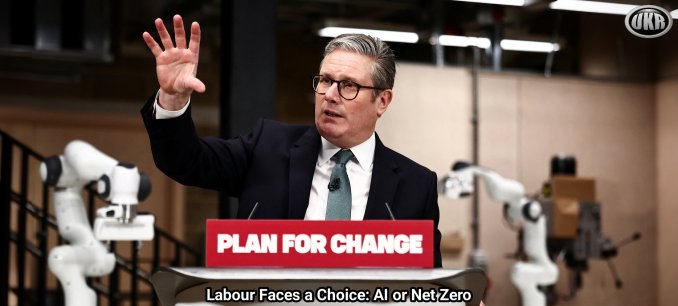
Labour faces a choice: AI or net zero
New technology requires data centres whose energy needs are likely to increase emissions
The Government is a big fan of AI data centres. So much so that a year ago, it designated them as critical national infrastructure.
Preliminary analysis for the Government found that UK data centre capacity could rise from around 2 gigawatts (GW) today to as much as 6.3 GW by 2030, but even that may not be enough to meet demand.
Although data centres can be located anywhere, there are various reasons why it is useful to locate them near to users – reduced latency for one. The economic benefits of hosting them in Britain is also particularly attractive for a Government that is struggling to deliver its promised economic growth.
But whether we can power these data centres is a very big question.
The British power grid is in dire straits. Ed Miliband, the Energy Secretary, is about the only person left in the country who still believes in his Clean Power 2030 Plan.
Many of us are instead wondering how we will keep the lights on with existing demand in 2030, never mind the additional load of both AI data centres and the increased use of electric heating and cars Miliband wants to see.
When it comes to energy, the Government’s focus in recent years has been on building lots of renewable generation, with large amounts of wind and solar power connected to the grid. We now have a wind fleet that is similar in size to the gas fleet.
But unlike gas, which is about 86pc available, windfarms on average run only 35pc of the time. This is a problem for normal consumers, never mind data centres, many of which require so-called “five nines” availability – that is, they must be running 99.999pc of the time.
While data centres used for AI training could accept lower reliability, no tech company will be happy to only operate a third of the time (or a tenth, which is the availability of solar).
It is vital we maintain our fleet of gas power stations to meet demand when there is no wind or sun, which happens far more often than people might think.
Despite over 32 GW of wind capacity now on the grid, it’s not unusual for output to fall below 1GW and to remain at low levels for days at a time. Batteries cannot solve the problem as they run out of charge after just a couple of hours on average.
The really bad news is that about a third of the gas fleet was built in the 1990s and is nearing end of life. Some 12 GW of the fleet is at risk of closure by 2030, along with just under 5 GW of nuclear power.
The new nuclear project at Hinkley Point will provide 3.2 GW but is unlikely to open before 2030, although 2-3 GW of smaller gas units could open this decade.
Overall we could lose around 12 GW of firm, non-intermittent power generation capacity by 2030. To put this in context, peak winter demand is around 47 GW – so that is a significant loss.
The Telegraph: continue reading
Featured image: The Telegraph

••••
The Liberty Beacon Project is now expanding at a near exponential rate, and for this we are grateful and excited! But we must also be practical. For 7 years we have not asked for any donations, and have built this project with our own funds as we grew. We are now experiencing ever increasing growing pains due to the large number of websites and projects we represent. So we have just installed donation buttons on our websites and ask that you consider this when you visit them. Nothing is too small. We thank you for all your support and your considerations … (TLB)
••••
Comment Policy: As a privately owned web site, we reserve the right to remove comments that contain spam, advertising, vulgarity, threats of violence, racism, or personal/abusive attacks on other users. This also applies to trolling, the use of more than one alias, or just intentional mischief. Enforcement of this policy is at the discretion of this websites administrators. Repeat offenders may be blocked or permanently banned without prior warning.
••••
Disclaimer: TLB websites contain copyrighted material the use of which has not always been specifically authorized by the copyright owner. We are making such material available to our readers under the provisions of “fair use” in an effort to advance a better understanding of political, health, economic and social issues. The material on this site is distributed without profit to those who have expressed a prior interest in receiving it for research and educational purposes. If you wish to use copyrighted material for purposes other than “fair use” you must request permission from the copyright owner.
••••
Disclaimer: The information and opinions shared are for informational purposes only including, but not limited to, text, graphics, images and other material are not intended as medical advice or instruction. Nothing mentioned is intended to be a substitute for professional medical advice, diagnosis or treatment.
Disclaimer: The views and opinions expressed in this article are those of the author and do not necessarily reflect the official policy or position of The Liberty Beacon Project.






Leave a Reply